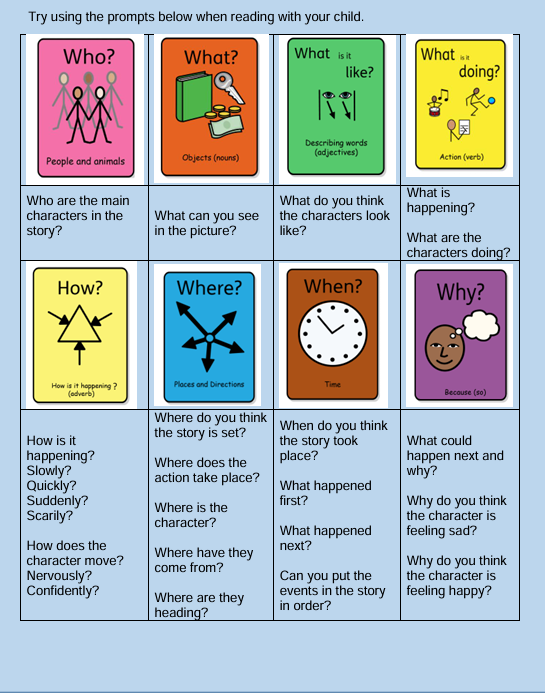Inclusion
Pilgrims’ Way Primary school prides itself on being an inclusive and diverse primary school which teaches pupils from the ages of 3-11.

We value each pupil’s uniqueness, and their differences are recognised and celebrated.
Our inclusive approach means that we have carefully considered how we provide an irresistible, broad and balanced curriculum that meets the needs of all our pupils.

By teaching an irresistible curriculum through inclusive practice, underpinned by our school values, pupils are confident, have high wellbeing, enjoy learning, make progress and achieve at Pilgrims’ Way.
We have highly skilled and trained staff who are knowledgeable in teaching and supporting the learning of our children. Our learning environments are welcoming, calm, organised and stimulating. Our pupils succeed through Quality First Teaching. The Mainstream Core Standards are used to create a core offer of approaches and strategies tailored to each class or individual’s needs and abilities. This support enables children to access the curriculum, with learning scaffolded to support learners’ diverse needs. The curriculum is designed to make learning relevant and meaningful by embedding context, firsthand experiences and activating pupil’s prior knowledge. Pupils are given opportunities to demonstrate their learning through cultural and personal links.

It's not about pupils getting the same. It's about pupils getting what they need!
Provision outside of class is considered for brief periods to meet specific needs e.g. through use of forest school, Drawing and Talking work, speech provision. All teaching opportunities are designed to develop language and literacy so that pupils become fluent in both the social and academic language of the primary curriculum.
The Inclusion Team
Our Inclusion Team has been developed to widen the school's offer of support to children and their families. The team is lead by Mrs Watts, the Inclusion Lead and SENCo. The team have specialist skills and knowledge and work closely with outside professionals. They offer coaching in best practice for all children to other members of staff. They support with modelling strategies and interventions and monitor provision. They also undertake pupil assessments and support children across the school with targeted and personalised support.
Mrs Walsh, Ms Redman and Mrs Woods lead support for speech, language and communication needs.
Miss Potts supports with Makaton across the Early Years and targeted support where needed in other years.
Helen our FLO, Mr Walsh, our Forest School lead and Mrs Anderson all provide social, emotional and mental health support for children.
We work closely with parents and carers to actively support their children’s learning and wellbeing.
Mrs Smith is a SENCo and can be contacted for advice on Autism, ADHD and referrals to outside agencies. Her email is zara.smith@pilgrims-way.kent
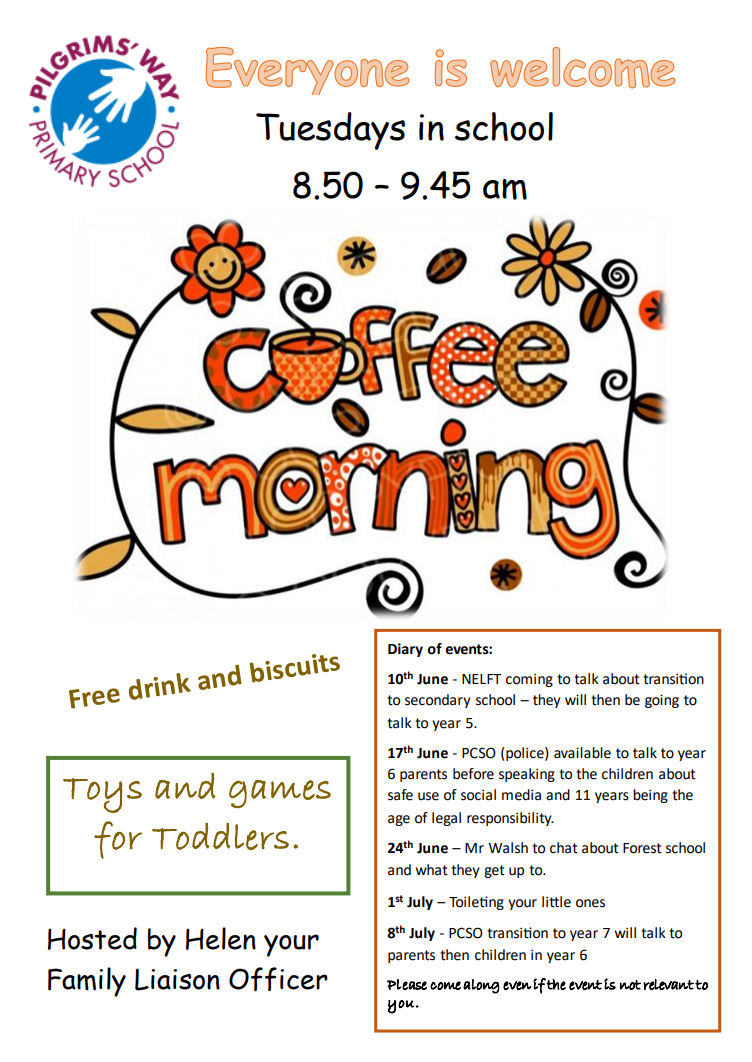
Olivia Watts is happy to meet with parents regarding any queries, specific needs or concerns. She can be contacted via the school office or email: olivia.watts@pilgrims-way.kent
Please click on the links on the right for further information on Special Educational Needs and Disabilities (SEND), Bilingual and Multilingual Learners and Young Carers.
Mainstream Core Standards
The Mainstream Core Standards
The Mainstream Core Standards guide for parents
Supporting, speech, language and communication (SLC) at Pilgrims' Way
At Pilgrims' Way, we understand how important speech, language, and communication skills are for every child’s learning, emotional wellbeing, and social development. These skills are the building blocks for success at school and beyond — helping children to build friendships, express their needs, and achieve their potential.
What is speech, language and communication?
-
Speech is the act of producing sounds that form words, allowing us to communicate verbally. It involves the physical process of using our vocal cords, mouth, and breath.
-
Language is the words and grammar used to communicate. It's how we express thoughts, ideas, and emotions, whether spoken, written, or signed.
-
Communication is the process of sharing information, thoughts, and feelings between people. It can be verbal (speech), non-verbal (gestures, facial expressions), written, or visual.
What types of difficulty can children have?
-
There are many different types of speech, language and communication needs (SLCN). Some examples are:
-
Difficulties understanding language: Such as struggling to follow instructions, or understanding what words mean.
-
Expressive language difficulties: Difficulty using language to communicate.
-
Speech sound disorders: Difficulty producing speech sounds correctly.
-
Stammering (Stuttering): Disruptions in the flow of speech.
-
Social Communication Difficulties: Challenges with using language in social contexts, such as understanding non-verbal cues or taking turns in conversation.
Find out more here Speech, language, and communication needs - Kent County Council
How We Support Your Child
In Kent, we are using the Balanced System® to help everyone work together to support pupils’ speech, language and communication. This means everyone involved in a child’s life can work together in a more joined up-way with the speech and language therapy service.
We work closely with our NHS link speech and language therapist, who regularly visits our school. They support us to review and develop our approach, advise staff, and work with individual pupils or small groups where needed.
Our current link therapist is Lily Bell — your child may see them in class, in groups, or around the school.

Our Commitment – The Five Strands of the Balanced System®
We are working to ensure that...
-
We help parents and carers build the confidence, knowledge, and skills to support their child. Pupils are also encouraged to make choices about the support they receive (Family Support)
-
We create communication-friendly classrooms and learning spaces where every child can understand and express themselves (Environment)
-
Our staff are trained to spot speech, language, and communication needs and know how to support pupils effectively (Workforce)
-
We identify any needs as early as possible so children get the help they need quickly (Identification)
-
Where needed, we provide specific support to help children make progress (Intervention)
Levels of Support Available
Every child benefits from support at different levels. Some may need more targeted or specialist help at times in addition to universal support:
-
Universal Support – For all pupils. For example, using visual aids, clear instructions, and communication-friendly teaching strategies.
-
Targeted Support – For pupils who need extra help. This could include small group work or pre-teaching key vocabulary.
-
Specialist Support – For pupils with more complex needs. For example, therapy for a child with a complex speech sound disorder
Our Current Focus
Over the past year, we have been working on ensuring our classrooms develop their use of
Communication friendly strategies. Within the plans for our new school, we have considered the speech, language and communication needs of our pupils. The new school will be neutral in colour and design and the environment has a reduced sensory load- for example spaces will be soundproofed, lighting will be installed that reduces glare as much as possible, and several new spaces will be available for use for intervention. We strive to use a total communication approach in our classrooms through use of consistent visual supports. We have been working on explicit vocabulary teaching and the use of Language through Colour (see tab below). Talk is a vital component of every lesson and crucial for developing communication skills, promoting active learning, enhancing understanding and developing critical thinking skills.
Stay and play parent workshops are held to model play and speech, language and communication skills for Year R parents and carers. Staff emphasise to parents the need to give time to talk with their children using everyday opportunities.
If you have any concerns about your child’s speech, language or communication skills, please speak to your child’s class teacher first. We will then work together to agree on the next steps.
If necessary, we may discuss your child’s needs with our link therapist and develop a plan. You will be kept informed about any plans to support your child.
An important principle of the Balanced System® is ensuring that what matters most to you and your child is central to agreeing on outcomes and setting targets.
Useful websites for parents
Speech, language, and communication needs - Kent County Council (general information about SLCN in Kent including how to access support)
The Pod - KCHFT – (information and resources including workshops delivered by Kent speech and language therapists)

BBC Tiny Happy People (advice and activities for all parents to support speech, language and communication development, up to age 5).
Home - Speech and Language UK: Changing young lives (national charity, lots of information, resources and advice translated into different languages)
Children develop their speech, language and communication skills at different rates. However, knowing what is typical can help you identify speech and language problems early. The following link has a progress checker to see how your child is getting on with their talking and understanding of words. https://speechandlanguage.org.uk/help-for-families/ages-and-stages
SLCN - Afasic (national charity – information and resources). Afasic supports and provides information for families with children and young adults who have Speech Language and Communication Needs (SLCN) with a focus on Developmental Language Disorder (DLD)
RADLD - Raising Awareness of Developmental Language Disorder - RADLD
Parent Portal - Speech and Language Link (information about development and activities to support including for teenagers)
Words for Life | National Literacy Trust | Words for Life (parent advice to support language, literacy and communication for up to 12 years)
Zone In | Words for Life (Tips on boosting reading, writing, speaking and listening skills for young people age 14+)
The Balanced System® in Kent for Speech Language and Communication Needs (SLCN) – KELSI (information aimed at schools and professionals, but may be of interest to parents wanting to understand how the Balanced System works in more detail)
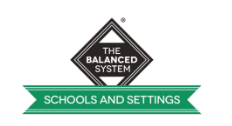
Balanced System ® Scheme for Schools and Settings:
Our school has taken up an opportunity to work towards a nationally recognised ‘Balanced System ®: Scheme for Schools and Settings’ accreditation, created by Better Communication CIC and endorsed by NAPLIC and Afasic.
We are working to develop our provision for speech, language and communication needs across the whole school with the support of a local mentor. To achieve accreditation, we will provide impact evidence to show the difference we are making for pupils and their families.
Among other evidence, we will capture staff, pupil and family voice to show the lived experience of how speech, language and communication needs are being supported across the school and how this is making a difference.
For more information about the Balanced System® in schools and how speech and language therapy services are working, visit KELSI.
How we use Assistive Technology in school
Pilgrims’ Way has been awarded an ‘Innovator’s in Assistive Technology’ badge. This means that staff have been recognised for embracing assistive technology (AT) to support teaching within everyday classroom practice. AT can help to remove barriers to learning, support learners to work more independently and allow them to demonstrate their knowledge, skills and understanding in different ways. For example, where a pupil may struggle to read independently, using a ‘text to speech’ feature lets them read any text they choose. Similarly, by using 'speech to text', a pupil is able to dictate what they want to write rather than having to type it. This has clear benefits for pupils who struggle with spelling, handwriting or keyboard skills. Translation tools are also used in every classroom practice to enhance language development by supporting learning in home language and English.
Here are some of the tools that we currently use in school:

Supporting children's emotional regulation
Regulation is key to having fun, completing tasks, working effectively with others, maintaining healthy and meaningful relationships, achieving and having an overall sense of well-being. It plays a huge role in finding success in school and in life.
Parents and Carers – What can you do to help?
All the adults working with children in school are trained regularly to understand and use Colour Monster and The Zones of Regulation daily in class and around school. We encourage parents and carers to have these same discussions with children at home and to model your own feelings.
The Colour Monster
For younger children in school, we teach emotions using a story called The Colour Monster. It is important for children to learn to identify and express a wide range of feelings, while also understanding that others have feelings, too.
There are large colour monster displays containing pictures and words in each classroom, so the children can add their name card to the emotion they are feeling. At a point during the day, an adult will offer to discuss how the child is feeling, particularly if the emotion is a negative one.
The displays give children the language to help them describe and express how they are feeling which is such an important part of their emotional development.



These links are for video clips of Colour Monster stories you may want to watch -
https://www.youtube.com/watch?v=IY6d1jyvmVg&t=14s The Colour Monster
https://www.youtube.com/watch?v=vj5V9tPY04Q&t=5s The Colour Monster goes to School
Zones of Regulation
For older children we teach emotions and regulation through 'Zones of Regulation'. Using The Zones Check-In provides common language and a visual system to help pupils express how they are feeling in each of the Zones and what regulation tools they might need.
The Zones of Regulation framework categorises our emotions and energy states into four colour-coded Zones:
-
Blue (low energy such as sad or tired)
-
Green (neutral energy such as calm and focused)
-
Yellow (elevated energy such as frustrated or excited)
-
Red (highest energy such as angry or overjoyed).
Adults and children of all ages move through a wide range of emotions, energy, and alertness throughout the day. All feelings and Zones are a natural part of being human.
The Zones help children to learn that everyone experiences all types of feelings and emotions. The Zones are neutral and do not communicate judgement - No Zone is bad.
Adults comment aloud about their own energy and emotions. That way, the children know it is natural that we all experience the different zones and use strategies to self-regulate.
Children are praised for identifying their emotions. Children are encouraged to share the Zone they are in and what they need to do to be 'green'.
Adults show interest about the triggers and tools pupils use to move between them.
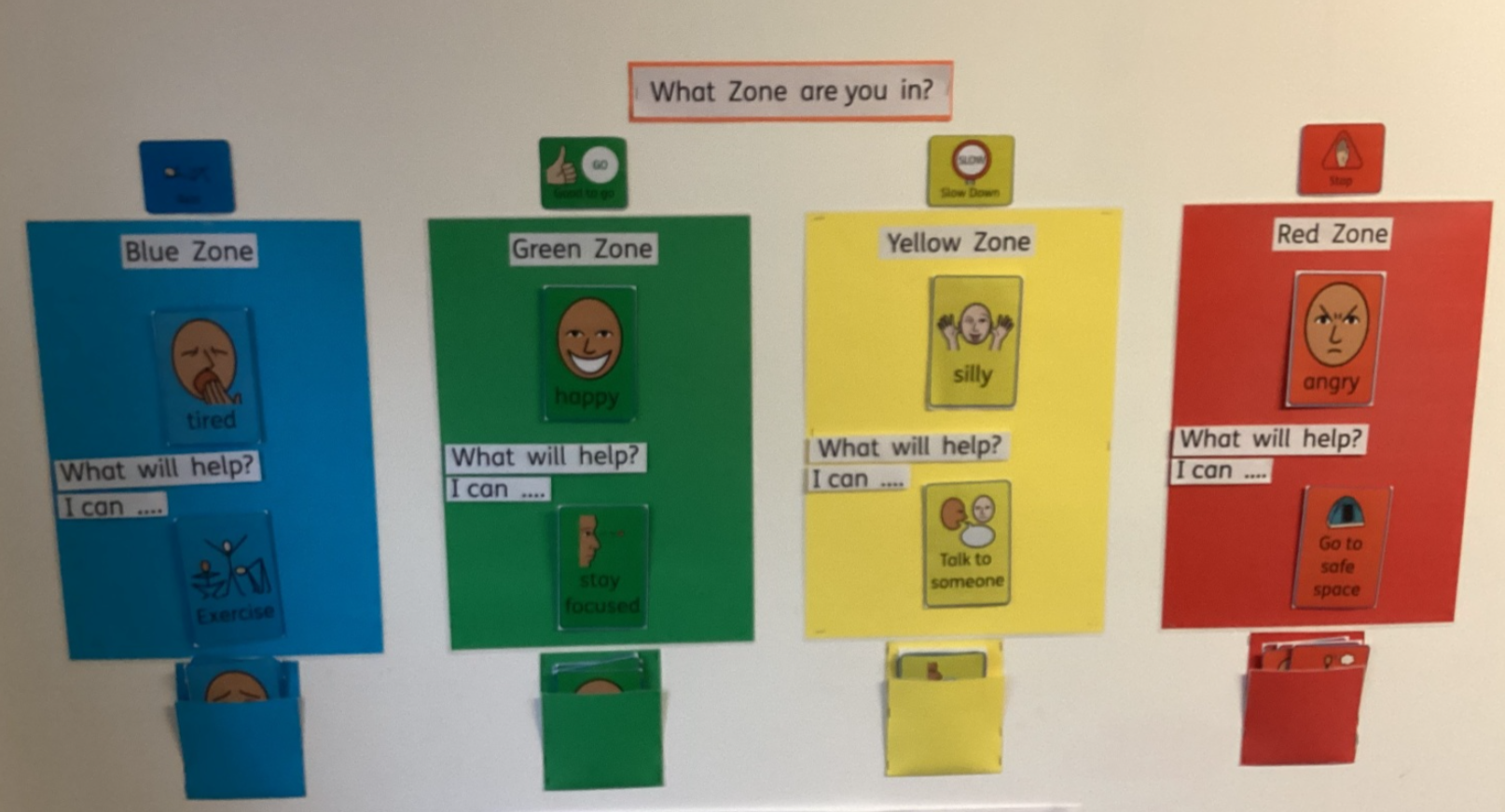
A Zones of Regulation display in class
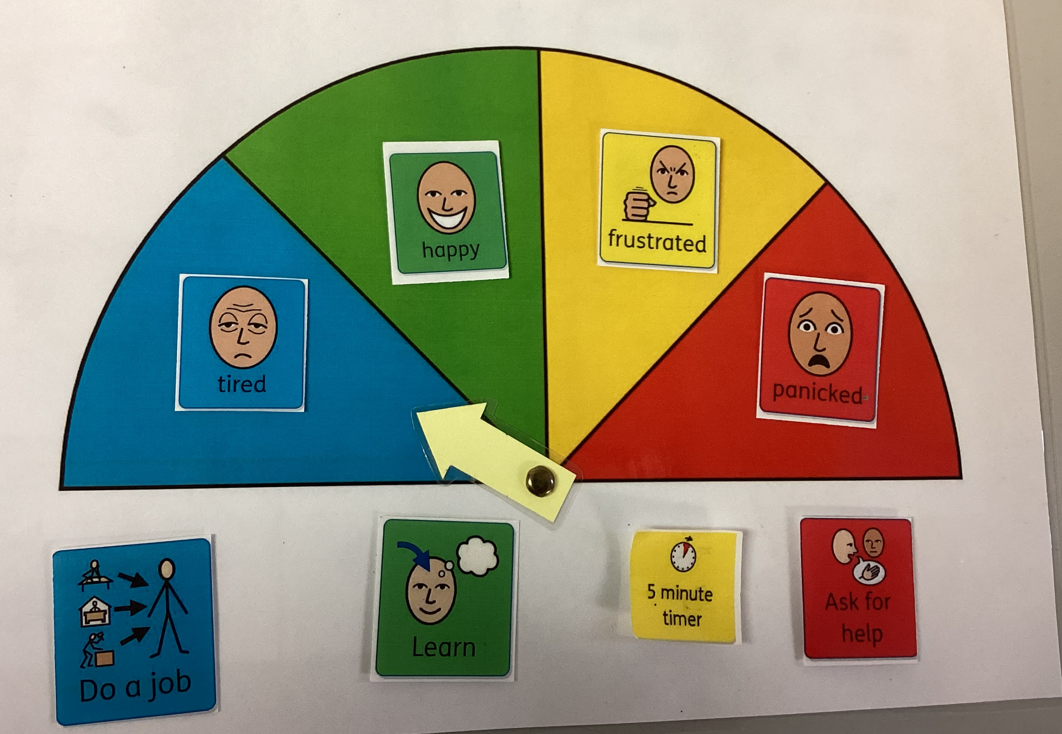
A 'Zones board' for use by individual pupils at school and at home
A parents guide to Language through Colour
Language through Colour (LTC)
We wanted to share a learning approach we are using called Language through Colour (LTC). You may have heard your child(ren) talk about it and seen the vocabulary in colours on the Knowledge Organisers we share with you.
What is LTC?
LTC is an inclusive approach used across the school and throughout the curriculum to support children’s language development.
How does it work?
-
We use LTC as a framework for pupils to understand and make connections with their learning.
-
Categories of words or phrases are colour coded according to the type of information they convey (e.g. action, person, doing word etc).
-
Each category is also linked to a question.

How do we use LTC in the classroom?
-
To help pupils to understand word categories e.g. nouns, adjectives, verbs, adverbs etc
-
To help pupils to build sentences both orally and written. Pupils are given prompts for information needed and the order in which to place words.
-
To help pupils to understand questions and how to answer them appropriately.
-
To help pupils to identify keywords or pieces of information from stories/events/ displays on word walls.
-
To support pupils to self assess, revisit, improve and extend their written work e.g, 'I have not added enough green words describing words/adjectives'.
Examples of Use
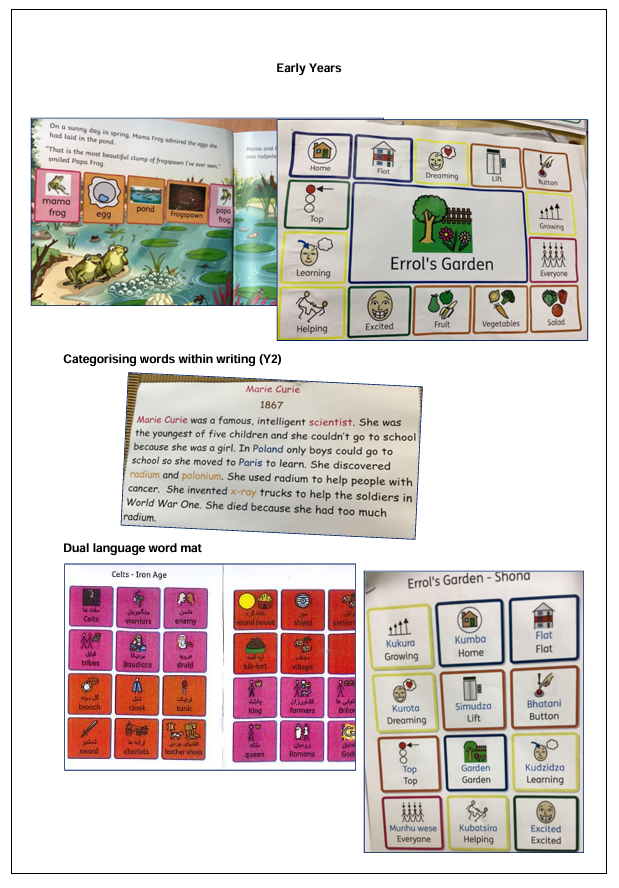
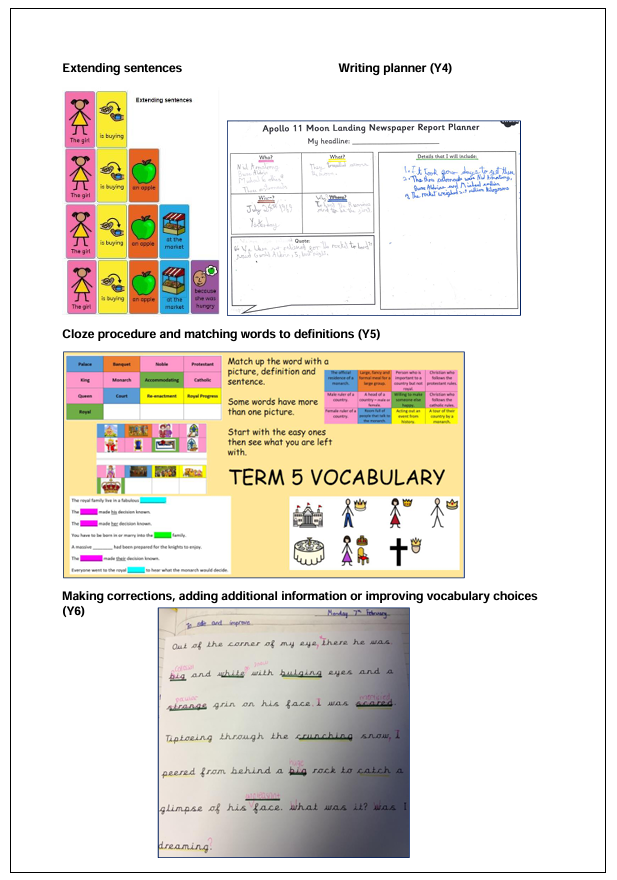
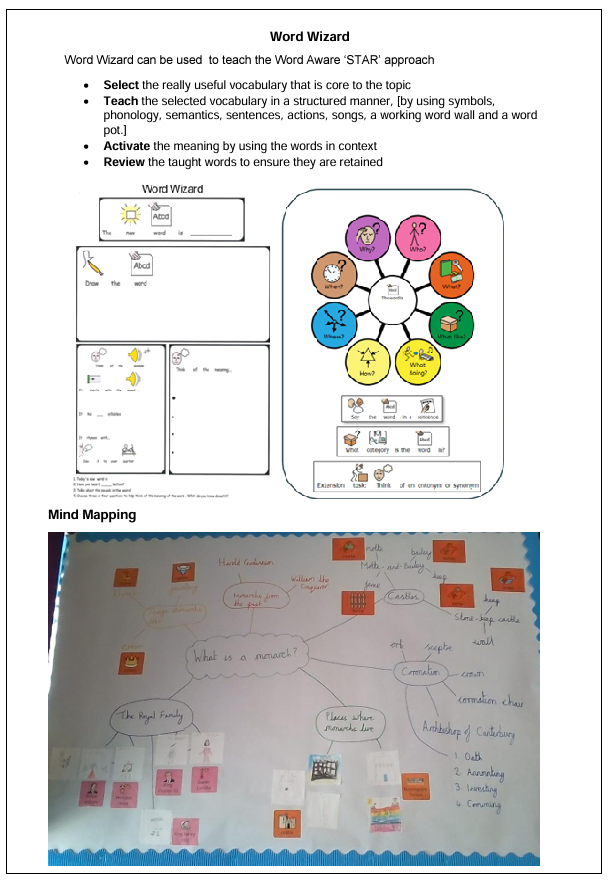
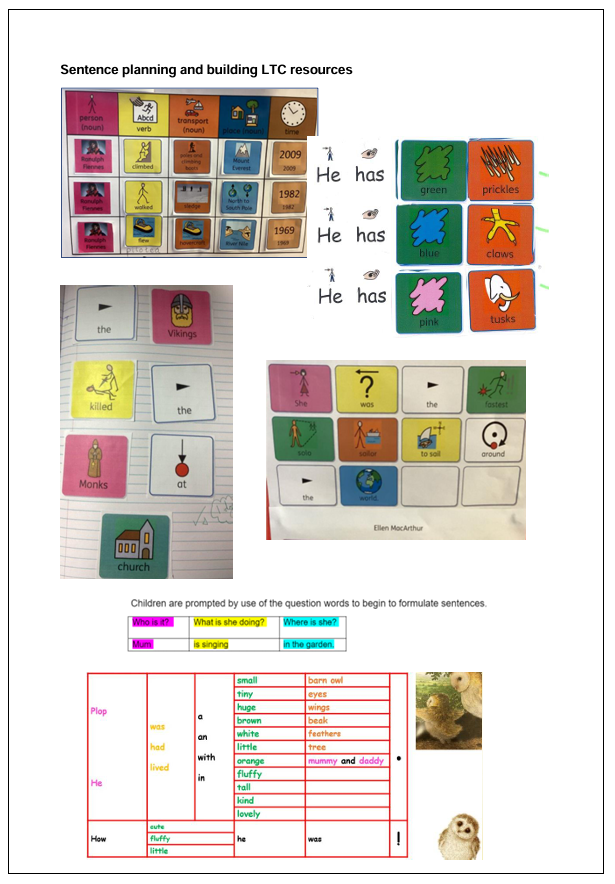
How Language through Colour can be used at home to support reading
Try using the prompts below when reading with your child.
